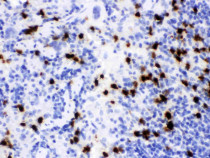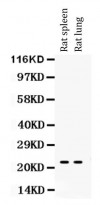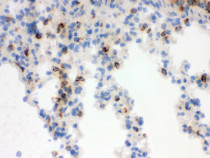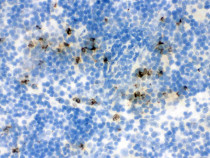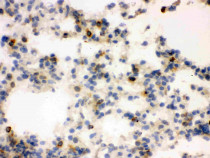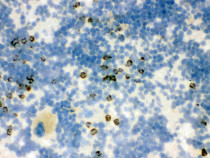ARG40931
anti-Lipocalin 2 antibody
anti-Lipocalin 2 antibody for IHC-Frozen sections,IHC-Formalin-fixed paraffin-embedded sections,Western blot and Mouse,Rat
Overview
| Product Description | Rabbit Polyclonal antibody recognizes Lipocalin 2 |
|---|---|
| Tested Reactivity | Ms, Rat |
| Tested Application | IHC-Fr, IHC-P, WB |
| Host | Rabbit |
| Clonality | Polyclonal |
| Isotype | IgG |
| Target Name | Lipocalin 2 |
| Antigen Species | Mouse |
| Immunogen | Recombinant protein corresponding to Q21-N200 of Mouse Lipocalin 2. |
| Conjugation | Un-conjugated |
| Alternate Names | Siderocalin LCN2; Oncogene 24p3; MSFI; 25 kDa alpha-2-microglobulin-related subunit of MMP-9; Lipocalin-2; p25; Neutrophil gelatinase-associated lipocalin; 24p3; NGAL |
Application Instructions
| Application Suggestion |
|
||||||||
|---|---|---|---|---|---|---|---|---|---|
| Application Note | IHC-P: Antigen Retrieval: Heat mediation was performed in Citrate buffer (pH 6.0) for 20 min. * The dilutions indicate recommended starting dilutions and the optimal dilutions or concentrations should be determined by the scientist. |
Properties
| Form | Liquid |
|---|---|
| Purification | Affinity purification with immunogen. |
| Buffer | 0.2% Na2HPO4, 0.9% NaCl, 0.05% Sodium azide and 4% Trehalose. |
| Preservative | 0.05% Sodium azide |
| Stabilizer | 4% Trehalose |
| Concentration | 0.5 mg/ml |
| Storage Instruction | For continuous use, store undiluted antibody at 2-8°C for up to a week. For long-term storage, aliquot and store at -20°C or below. Storage in frost free freezers is not recommended. Avoid repeated freeze/thaw cycles. Suggest spin the vial prior to opening. The antibody solution should be gently mixed before use. |
| Note | For laboratory research only, not for drug, diagnostic or other use. |
Bioinformation
| Database Links |
Swiss-port # P11672 Mouse Neutrophil gelatinase-associated lipocalin Swiss-port # P30152 Rat Neutrophil gelatinase-associated lipocalin |
|---|---|
| Gene Symbol | LCN2 |
| Gene Full Name | lipocalin 2 |
| Background | This gene encodes a protein that belongs to the lipocalin family. Members of this family transport small hydrophobic molecules such as lipids, steroid hormones and retinoids. The protein encoded by this gene is a neutrophil gelatinase-associated lipocalin and plays a role in innate immunity by limiting bacterial growth as a result of sequestering iron-containing siderophores. The presence of this protein in blood and urine is an early biomarker of acute kidney injury. This protein is thought to be be involved in multiple cellular processes, including maintenance of skin homeostasis, and suppression of invasiveness and metastasis. Mice lacking this gene are more susceptible to bacterial infection than wild type mice. [provided by RefSeq, Sep 2015] |
| Function | Iron-trafficking protein involved in multiple processes such as apoptosis, innate immunity and renal development. Binds iron through association with 2,5-dihydroxybenzoic acid (2,5-DHBA), a siderophore that shares structural similarities with bacterial enterobactin, and delivers or removes iron from the cell, depending on the context. Iron-bound form (holo-24p3) is internalized following binding to the SLC22A17 (24p3R) receptor, leading to release of iron and subsequent increase of intracellular iron concentration. In contrast, association of the iron-free form (apo-24p3) with the SLC22A17 (24p3R) receptor is followed by association with an intracellular siderophore, iron chelation and iron transfer to the extracellular medium, thereby reducing intracellular iron concentration. Involved in apoptosis due to interleukin-3 (IL3) deprivation: iron-loaded form increases intracellular iron concentration without promoting apoptosis, while iron-free form decreases intracellular iron levels, inducing expression of the proapoptotic protein BCL2L11/BIM, resulting in apoptosis. Involved in innate immunity, possibly by sequestrating iron, leading to limit bacterial growth. [UniProt] |
| Cellular Localization | Secreted. Note=Upon binding to the SLC22A17 (24p3R) receptor, it is internalized. [UniProt] |
| Calculated MW | 23 kDa |
Images (7) Click the Picture to Zoom In
-
ARG40931 anti-Lipocalin 2 antibody IHC-P image
Immunohistochemistry: Paraffin-embedded Mouse Spleen Tissue. Antigen Retrieval: Heat mediation was performed in Citrate buffer (pH 6.0, epitope retrieval solution) for 20 min. The tissue section was blocked with 10% goat serum. The tissue section was then stained with ARG40931 anti-Lipocalin 2 antibody at 1 µg/ml, overnight at 4°C.
-
ARG40931 anti-Lipocalin 2 antibody WB image
Western blot: 50 µg of samples under reducing conditions. Rat spleen and Rat lung lysates stained with ARG40931 anti-Lipocalin 2 antibody at 0.5 µg/ml, overnight at 4°C.
-
ARG40931 anti-Lipocalin 2 antibody IHC-P image
Immunohistochemistry: Paraffin-embedded Rat spleen tissue. Antigen Retrieval: Heat mediation was performed in Citrate buffer (pH 6.0, epitope retrieval solution) for 20 min. The tissue section was blocked with 10% goat serum. The tissue section was then stained with ARG40931 anti-Lipocalin 2 antibody at 1 µg/ml, overnight at 4°C.
-
ARG40931 anti-Lipocalin 2 antibody IHC-Fr image
Immunohistochemistry: Frozen section of Mouse lung tissue. The tissue section was blocked with 10% goat serum. The tissue section was then stained with ARG40931 anti-Lipocalin 2 antibody at 1 μg/ml dilution, overnight at 4°C.
-
ARG40931 anti-Lipocalin 2 antibody IHC-Fr image
Immunohistochemistry: Frozen section of Mouse spleen tissue. The tissue section was blocked with 10% goat serum. The tissue section was then stained with ARG40931 anti-Lipocalin 2 antibody at 1 μg/ml dilution, overnight at 4°C.
-
ARG40931 anti-Lipocalin 2 antibody IHC-Fr image
Immunohistochemistry: Frozen section of Rat lung tissue. The tissue section was blocked with 10% goat serum. The tissue section was then stained with ARG40931 anti-Lipocalin 2 antibody at 1 μg/ml dilution, overnight at 4°C.
-
ARG40931 anti-Lipocalin 2 antibody IHC-Fr image
Immunohistochemistry: Frozen section of Rat spleen tissue. The tissue section was blocked with 10% goat serum. The tissue section was then stained with ARG40931 anti-Lipocalin 2 antibody at 1 μg/ml dilution, overnight at 4°C.
